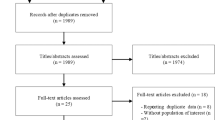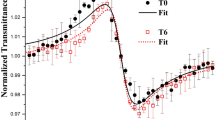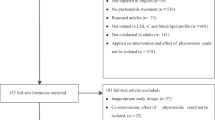Abstract
Background/Objectives:
To more precisely quantify the effect of barley β-glucan on blood lipid concentrations in humans and to examine the factors that could affect its efficacy.
Subjects/Methods:
Eleven eligible randomized clinical trials published from 1989 to 2008 were identified from nine databases. Weighted mean effect sizes were calculated for net differences in lipid profile using a random effect model (RevMan 4.2).
Results:
Overall, barley and β-glucan isolated from barley lowered total and low-density lipoprotein (LDL) cholesterol concentrations by 0.30 mmol/l (95% confidence interval (CI): −0.39 to −0.21, P<0.00001) and 0.27 mmol/l (95% CI: −0.34 to −0.20, P<0.00001), respectively, compared with control. The pattern of cholesterol-lowering action of barley in this analysis could not be viewed as a dose-dependent response. There were no significant subgroup differences by type of intervention and food matrix.
Conclusions:
Increased consumption of barely products should be considered as a dietary approach to reduce LDL cholesterol concentrations.
This is a preview of subscription content, access via your institution
Access options
Subscribe to this journal
Receive 12 print issues and online access
$259.00 per year
only $21.58 per issue
Buy this article
- Purchase on Springer Link
- Instant access to full article PDF
Prices may be subject to local taxes which are calculated during checkout



Similar content being viewed by others
References
AbuMweis SS, Barake R, Jones PJH (2008). Plant sterols/stanols as cholesterol lowering agents: a meta-analysis of randomized controlled. Food Nutr Res 52, DOI: 10.3402/fnr.v52i0.1811.
Badr A, Muller K, Schafer-Pregl R, El Rabey H, Effgen S, Ibrahim HH et al. (2000). On the origin and domestication history of barley (Hordeum vulgare). Mol Biol Evol 17, 499–510.
Behall KM, Scholfield DJ, Hallfrisch J (2004a). Lipids significantly reduced by diets containing barley in moderately hypercholesterolemic men. J Am Coll Nutr 23, 55–62.
Behall KM, Scholfield DJ, Hallfrisch J (2004b). Diets containing barley significantly reduce lipids in mildly hypercholesterolemic men and women. Am J Clin Nutr 80, 1185–1193.
Behall KM, Scholfield DJ, Hallfrisch JG (2006). Barley beta-glucan reduces plasma glucose and insulin responses compared with resistant starch in men. Nutr Res 26, 644–650.
Biorklund M, van Rees A, Mensink RP, Onning G (2005). Changes in serum lipids and postprandial glucose and insulin concentrations after consumption of beverages with beta-glucans from oats or barley: a randomised dose-controlled trial. Eur J Clin Nutr 59, 1272–1281.
Brown L, Rosner B, Willett WW, Sacks FM (1999). Cholesterol-lowering effects of dietary fiber: a meta-analysis. Am J Clin Nutr 69, 30–42.
Centre for Human Studies of Foodstuffs (2005). Clinical Study Report. Effects of boiled, flaked, milled barley powder product (Aktiv) on LDL-, HDL- and total cholesterol, triglycerides, glucose, insulin and HS-CRP levels in healthy hypercholesterolemic men and women. Centre for Human Studies of Foodstuffs (KPL): Uppsala. (Sponsored by NutriTech International AB, Kristianstad, Sweden.).
Charalampopoulos D, Wang R, Pandiella SS, Webb C (2002). Application of cereals and cereal components in functional foods: a review. Int J Food Microbiol 79, 131–141.
Cleeman JI, Grundy SM, Becker D, Clark LT, Cooper RS, Denke MA et al. (2001). Executive summary of the Third Report of the National Cholesterol Education Program (NCEP) expert panel on detection, evaluation, and treatment of high blood cholesterol in adults (Adult Treatment Panel III). JAMA–J Am Med Assoc 285, 2486–2497.
Deeks JJ, Higgins JPT, Altman DG (eds) (2005). Analysing and Presenting Results In: Cochrane Handbook for Systematic Reviews of Interventions 425 (updated May 2005); Section 8 www.cochrane-handbook.org.
El-Betagy A (2005). Food barley: importance, uses and local knowledge. Proceedings of the International Workshop on Food Barley Improvement. 14–17 Janaury 2002; Hammamet, Tunsia (Aleppo, Syrai, ICARDA).
Health Canada, Bureau of Nutritional Sciences (2002). Interim Guidance Document Preparing a Submission for Foods with Health Claims: Incorporating Standards of Evidence for Evaluation Foods with Health Claims. Health Canada, Bureau of Nutritional Sciences: Ottawa, Canada.
Hinata M, Ono M, Midorikawa S, Nakanishi K (2007). Metabolic improvement of male prisoners with type 2 diabetes in Fukushima Prison, Japan. Diabet Res Clin Pract 77, 327–332.
Keenan JM, Goulson M, Shamliyan T, Knutson N, Kolberg L, Curry L (2007). The effects of concentrated barley beta-glucan on blood lipids in a population of hypercholesterolaemic men and women. Br J Nutr 97, 1162–1168.
Keogh GF, Cooper GJS, Mulvey TB, McArdle BH, Coles GD, Monro JA et al. (2003). Randomized controlled crossover study of the effect of a highly beta-glucan-enriched barley on cardiovascular disease risk factors in mildly hypercholesterolemic men. Am J Clin Nutr 78, 711–718.
Li J, Kaneko T, Qin LQ, Wang J, Wang Y (2003). Effects of barley intake on glucose tolerance, lipid metabolism, and bowel function in women. Nutrition 19, 926–929.
McIntosh GH, Whyte J, McArthur R, Nestel PJ (1991). Barley and wheat foods—influence on plasma-cholesterol concentrations in hypercholesterolemic men. Am J Clin Nutr 53, 1205–1209.
Newman RK, Lewis SE, Newman CW, Boik RJ, Ramage RT (1989). Hypocholesterolemic effect of barley foods on healthy-men. Nutr Rep Int 39, 749–760.
Pai M, McCulloch M, Gorman JD, Pai N, Enanoria W, Kennedy G et al. (2004). Systematic reviews and meta-analyses: an illustrated, step-by-step guide. Natl Med J India 17, 86–95.
Pick ME, Hawrysh ZJ, Gee MI, Toth E (1998). Barley Bread products improve glycemic control of type 2 subjects. Int J Food Sci Nutr 49, 71–78.
Ripsin CM, Keenan JM, Jacobs DR, Elmer PJ, Welch RR, Vanhorn L et al. (1992). Oat products and lipid lowering—a meta-analysis. JAMA–J Am Med Assoc 267, 3317–3325.
Shimizu C, Kihara M, Aoe S, Araki S, Ito K, Hayashi K et al. (2008). Effect of high beta-glucan barley on serum cholesterol concentrations and visceral fat area inJapanese men—a randomized, double-blinded, placebo-controlled trial. Plant Foods Hum Nutr 63, 21–25.
Sundberg B (2008). Cholesterol lowering effects of a barley fibre flake products. AgroGOOD Industry Hi-tech 19, 14–17.
Theuwissen E, Mensink RP (2008). Water-soluble dietary fibers and cardiovascular disease. Physiol Behav 94, 285–292.
Truswell AS (2002). Cereal grains and coronary heart disease. Eur J Clin Nutr 56, 1–14.
Acknowledgements
We thank Tracy Lee Exley, Stephen Capelle and Camille Rhymer for their assistance in literature search and systematic review. This study was supported by the Agriculture and Agri-Food Canada and the Alberta Barley Commission. The funders had no role in the design, analysis or interpretation of the study.
Author information
Authors and Affiliations
Corresponding author
Ethics declarations
Competing interests
The authors declare no conflict of interest.
Additional information
Contributors: SSA assessed the study quality, extracted data, performed statistical analysis, interpreted the results, and wrote and edited the paper. SJ was involved in literature search, electronic searches, study selection and quality assessment, data extraction and contributed to writing the paper. NA developed study concept, carried out initial study assessment and provided critical revision of the paper.
Rights and permissions
About this article
Cite this article
AbuMweis, S., Jew, S. & Ames, N. β-glucan from barley and its lipid-lowering capacity: a meta-analysis of randomized, controlled trials. Eur J Clin Nutr 64, 1472–1480 (2010). https://doi.org/10.1038/ejcn.2010.178
Received:
Revised:
Accepted:
Published:
Issue Date:
DOI: https://doi.org/10.1038/ejcn.2010.178
Keywords
This article is cited by
-
Plasma fat-soluble vitamin and carotenoid concentrations after plant sterol and plant stanol consumption: a meta-analysis of randomized controlled trials
European Journal of Nutrition (2017)
-
The 2015 Dutch food-based dietary guidelines
European Journal of Clinical Nutrition (2016)
-
A systematic review and meta-analysis of randomized controlled trials of the effect of barley β-glucan on LDL-C, non-HDL-C and apoB for cardiovascular disease risk reductioni-iv
European Journal of Clinical Nutrition (2016)
-
Lipid Lowering with Soluble Dietary Fiber
Current Atherosclerosis Reports (2016)
-
How Well Can We Control Dyslipidemias Through Lifestyle Modifications?
Current Cardiology Reports (2016)



